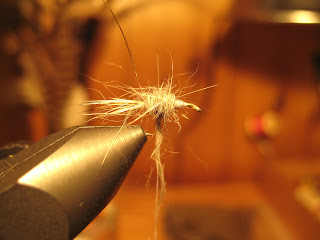
The Gold Ribbed Hare's Ear
Materials needed:
Hook: TMC 5262, or any standard nymph hook (#8-18)
Weight: (optional) .010 lead wire
Thread: Gray UTC 8/0 or 6/0
Tail: Guard hares from rabbit (hare) fur/mask
Rib: Gold wire, or size small gold tinsel
Body: Dubbed gray rabbit under fur, with few guard hares
Wing case: Molted turkey tail feather
Thorax: Mixed, brown, gray rabbit under fur, with guard hairs
Legs: Thorax dubbing, teased out with a dubbing brush/velcro
The Gold Ribbed Hares Ear was developed to imitate lighter species of mayfly, and even caddis larvae. I'll often dead drift this fly, followed by a darker nymph like a Pheasant Tail Nymph when I'm searching for fish and don't know what they are eating. It can be tied in a variety of sizes, and colors. A piece of pearl tinsel can be tied in instead of the turkey feather wing case to make a flash back. A gold bead is often tied in as well for added weight. I have also had luck with using dyed black dubbing with a silver rib.
 Start your thread just behind your lead wire wraps. Wrap your thread over your lead as perpendicular as possible so the lead stays in tightly wrapped coils around the hook shank, and doesn't uncoil your lead, as shown in the photo.
Start your thread just behind your lead wire wraps. Wrap your thread over your lead as perpendicular as possible so the lead stays in tightly wrapped coils around the hook shank, and doesn't uncoil your lead, as shown in the photo.You should now be able to wrap your thread normally over the lead without the thread separating the lead wraps. Completely cover the lead wraps with thread. You can optionally put a coat of head cement over your thread and lead to help hold it all in place. You do not want the lead rotating around the hook shank, if it does, start over, this time wrapping your thread tighter. If it rotates around the hook, the fly will start falling apart after just a few fish.
Cut some guard hairs (the longer fibers shown in the picture) from a hares mask, or body. Pull out and discard as much of the gray underfur (short, fuzzy stuff) as you can. These guard hairs will be your tail.
The tail should be about the length of the shank, from the eye to the bend. Always measure to be sure.
After you have measured your tail length, carefully transfer the tail fibers to your other hand, and tie them in with a light wrap, followed by a few tight wraps. Make sure its tight enough to hold your tail in place, and doesn't rotate around the hook, or pull out.
Tie in your rib after your tail is secured to the hook.
Gather some underfur (the short, usually gray, fuzzy stuff closest to the body of the hare) with as few guard hairs as possible.
Dub some of this fur onto your thread. Always twist dubbing onto the thread in the same direction. Clockwise, or counter-clockwise, it doesn't matter, just choose one and stick with it. This will help keep the dubbing in place.
Make one wrap of dubbed thread behind the ribbing material, then continue wrapping the dubbing forward, toward the eye of the hook, building a taper as you go. It should be thin in the back near the tail, and thicker near the thorax. Stop when you reach the middle of the hook shank.
You can now wrap your rib evenly, and tightly over the body, and tie it off with thread. This helps keep the dubbing from falling out.
To make a wing case, select a section of molted turkey tail feather fibers. The fibers should be about the width of the hook gap. You can optionally put some head cement on this section of fibers to keep them together. I use Sally Hanson's Hard as Nails for this.
Tie in your wing case, up to the body as shown with a few soft wraps followed by a few tight wraps. I tie in the thinner, tips of the turkey tail fibers because they are easier to work with than the thicker part where you cut the fibers from the feather.
I like to make my thorax a slightly darker color than the body. To achieve this, get some gray underfur as used in the body, and mix it with an equal amount of brown underfur, and guard hairs. To blend the three types of dubbing, put it all together and pull it apart several times until you have an even mix of colors.
Apply this dubbing mixture liberally to your thread. You want your thorax to match the thickest part of the body that it butts up to.
Wrap your thorax thick and even, make sure you leave enough room at the eye of the hook to finish the fly
Fold the wing case over the thorax, tie a whip finish, and apply head cement.
Using a dubbing brush, or piece of velcro, "tease" out the dubbing on the thorax to form legs. Pull out the longer, out of place fibers. The legs should not reach the bend in the hook when folded back.















No comments:
Post a Comment